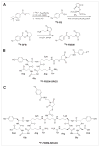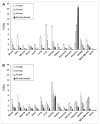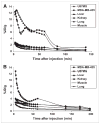A thiol-reactive 18F-labeling agent, N-[2-(4-18F-fluorobenzamido)ethyl]maleimide, and synthesis of RGD peptide-based tracer for PET imaging of alpha v beta 3 integrin expression
- PMID: 16818952
- PMCID: PMC1704081
A thiol-reactive 18F-labeling agent, N-[2-(4-18F-fluorobenzamido)ethyl]maleimide, and synthesis of RGD peptide-based tracer for PET imaging of alpha v beta 3 integrin expression
Abstract
The cell adhesion molecule integrin alpha v beta 3 plays a key role in tumor angiogenesis and metastasis. A series of 18F-labeled RGD peptides have been developed for PET of integrin expression based on primary amine-reactive prosthetic groups. In this study we introduced a new method of labeling RGD peptides through a thiol-reactive synthon, N-[2-(4-18F-fluorobenzamido)ethyl]maleimide (18F-FBEM).
Methods: 18F-FBEM was synthesized by coupling N-succinimidyl 4-18F-fluorobenzoate (18F-SFB) with N-(2-aminoethyl)maleimide. After high-pressure liquid chromatography purification, it was allowed to react with thiolated RGD peptides, and the resulting tracers were subjected to receptor-binding assay, in vivo metabolic stability assessment, biodistribution, and microPET studies in murine xenograft models.
Results: Conjugation of monomeric and dimeric sulfhydryl-RGD peptides with 18F-FBEM was achieved in high yields (85% +/- 5% nondecay-corrected on the basis of 18F-FBEM). The radiochemical purity of the 18F-labeled peptides was >98% and the specific activity was 100 approximately 150 TBq/mmol. Noninvasive microPET and direct tissue sampling experiments demonstrated that both 18F-FBEM-SRGD (RGD monomer) and 18F-FBEM-SRGD2 (RGD dimer) had integrin-specific tumor uptake in subcutaneous U87MG glioma and orthotopic MDA-MB-435 breast cancer xenografts.
Conclusion: The new tracer 18F-FBEM-SRGD2 was synthesized with high specific activity via 18F-FBEM and the tracer exhibited high receptor-binding affinity, tumor-targeting efficacy, metabolic stability, as well as favorable in vivo pharmacokinetics. The new synthon 18F-FBEM developed in this study will also be useful for radiolabeling of other thiolated biomolecules.
Figures







Similar articles
-
Click chemistry for (18)F-labeling of RGD peptides and microPET imaging of tumor integrin alphavbeta3 expression.Bioconjug Chem. 2007 Nov-Dec;18(6):1987-94. doi: 10.1021/bc700226v. Epub 2007 Nov 21. Bioconjug Chem. 2007. PMID: 18030991 Free PMC article.
-
N-[2-(4-[18F]Fluorobenzamido)ethyl]maleimide-sulfhydryl-cyclic-arginine-glycine-aspartic acid peptide.2007 Jul 6 [updated 2008 Feb 25]. In: Molecular Imaging and Contrast Agent Database (MICAD) [Internet]. Bethesda (MD): National Center for Biotechnology Information (US); 2004–2013. 2007 Jul 6 [updated 2008 Feb 25]. In: Molecular Imaging and Contrast Agent Database (MICAD) [Internet]. Bethesda (MD): National Center for Biotechnology Information (US); 2004–2013. PMID: 20641618 Free Books & Documents. Review.
-
microPET of tumor integrin alphavbeta3 expression using 18F-labeled PEGylated tetrameric RGD peptide (18F-FPRGD4).J Nucl Med. 2007 Sep;48(9):1536-44. doi: 10.2967/jnumed.107.040816. Epub 2007 Aug 17. J Nucl Med. 2007. PMID: 17704249 Free PMC article.
-
Pegylated Arg-Gly-Asp peptide: 64Cu labeling and PET imaging of brain tumor alphavbeta3-integrin expression.J Nucl Med. 2004 Oct;45(10):1776-83. J Nucl Med. 2004. PMID: 15471848
-
N-[2-(4-[18F]Fluorobenzamido)ethyl]maleimide-sulfhydryl-cyclic-arginine-glycine-aspartic acid dimeric peptide.2007 Jul 6 [updated 2008 Feb 25]. In: Molecular Imaging and Contrast Agent Database (MICAD) [Internet]. Bethesda (MD): National Center for Biotechnology Information (US); 2004–2013. 2007 Jul 6 [updated 2008 Feb 25]. In: Molecular Imaging and Contrast Agent Database (MICAD) [Internet]. Bethesda (MD): National Center for Biotechnology Information (US); 2004–2013. PMID: 20641375 Free Books & Documents. Review.
Cited by
-
Click chemistry for (18)F-labeling of RGD peptides and microPET imaging of tumor integrin alphavbeta3 expression.Bioconjug Chem. 2007 Nov-Dec;18(6):1987-94. doi: 10.1021/bc700226v. Epub 2007 Nov 21. Bioconjug Chem. 2007. PMID: 18030991 Free PMC article.
-
Fluorine-18: Radiochemistry and Target-Specific PET Molecular Probes Design.Front Chem. 2022 Jun 29;10:884517. doi: 10.3389/fchem.2022.884517. eCollection 2022. Front Chem. 2022. PMID: 35844642 Free PMC article. Review.
-
(68)Ga-labeled NOTA-RGD-BBN peptide for dual integrin and GRPR-targeted tumor imaging.Eur J Nucl Med Mol Imaging. 2009 Sep;36(9):1483-94. doi: 10.1007/s00259-009-1123-z. Epub 2009 Apr 10. Eur J Nucl Med Mol Imaging. 2009. PMID: 19360404
-
Preparation of 18F-labeled peptides using the copper(I)-catalyzed azide-alkyne 1,3-dipolar cycloaddition.Nat Protoc. 2011 Oct 13;6(11):1718-25. doi: 10.1038/nprot.2011.390. Nat Protoc. 2011. PMID: 22011654
-
Peptoid and Positron Emission Tomography: an Appealing Combination.Am J Nucl Med Mol Imaging. 2011;1(1):76-79. Am J Nucl Med Mol Imaging. 2011. PMID: 22022661 Free PMC article.
References
-
- Hood JD, Cheresh DA. Role of integrins in cell invasion and migration. Nat Rev Cancer. 2002;2:91–100. - PubMed
-
- Brooks PC, Stromblad S, Sanders LC, et al. Localization of matrix metalloproteinase MMP-2 to the surface of invasive cells by interaction with integrin αvβ3. Cell. 1996;85:683–693. - PubMed
-
- Bogenrieder T, Herlyn M. Axis of evil: molecular mechanisms of cancer metastasis. Oncogene. 2003;22:6524–6536. - PubMed
-
- Kumar CC. Integrin αvβ3 as a therapeutic target for blocking tumor-induced angiogenesis. Curr Drug Targets. 2003;4:123–131. - PubMed
Publication types
MeSH terms
Substances
Grants and funding
LinkOut - more resources
Full Text Sources
Other Literature Sources
Miscellaneous
